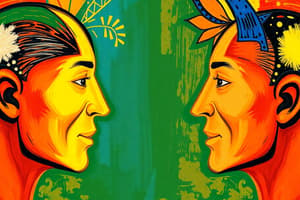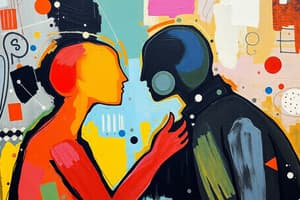Podcast
Questions and Answers
What is the main principle of Social Exchange Theory?
What is the main principle of Social Exchange Theory?
- People will help only in the presence of others
- People will help only if they are altruistic
- People will help only if they feel empathetic
- People will help if benefits outweigh costs (correct)
What is the motivation behind Egoistic helping?
What is the motivation behind Egoistic helping?
- To feel empathetic towards others
- To get something in return (correct)
- To reduce feelings of guilt
- To genuinely help others
What is the term for the phenomenon where people are less likely to help in the presence of others?
What is the term for the phenomenon where people are less likely to help in the presence of others?
- The Bystander Effect (correct)
- Pluralistic Ignorance
- Diffusion of Responsibility
- Social Exchange Theory
What is the term for when individuals monitor the reactions of other bystanders and conclude that they don't need to intervene?
What is the term for when individuals monitor the reactions of other bystanders and conclude that they don't need to intervene?
What is the 5-step model to helping developed by Darley and Latané?
What is the 5-step model to helping developed by Darley and Latané?
What is the negative-state relief hypothesis?
What is the negative-state relief hypothesis?
What is the term for the phenomenon where responsibility is diffused among a group of people?
What is the term for the phenomenon where responsibility is diffused among a group of people?
What is the empathy-altruism hypothesis?
What is the empathy-altruism hypothesis?
What is the primary focus of the Burnstein et al. study mentioned in the content?
What is the primary focus of the Burnstein et al. study mentioned in the content?
According to the content, what is the relationship between the degree of relatedness and the tendency to help?
According to the content, what is the relationship between the degree of relatedness and the tendency to help?
What is the name of the theory that explains learning by direct experience and vicarious experience?
What is the name of the theory that explains learning by direct experience and vicarious experience?
According to Social Learning Theory, what motivates individuals to learn and imitate behaviors?
According to Social Learning Theory, what motivates individuals to learn and imitate behaviors?
What is the term for learning through observing and copying the behavior of others?
What is the term for learning through observing and copying the behavior of others?
What is the outcome when social norms are adaptive and aligned with 'helping is good'?
What is the outcome when social norms are adaptive and aligned with 'helping is good'?
What is the primary difference between direct experience and vicarious experience in Social Learning Theory?
What is the primary difference between direct experience and vicarious experience in Social Learning Theory?
What is the underlying mechanism that drives Social Learning Theory?
What is the underlying mechanism that drives Social Learning Theory?
What is the primary difference between prosocial behaviour and helping behaviour?
What is the primary difference between prosocial behaviour and helping behaviour?
Which of the following is an example of altruistic behaviour?
Which of the following is an example of altruistic behaviour?
What is the main idea behind kin selection in evolutionary social psychology?
What is the main idea behind kin selection in evolutionary social psychology?
What is the bystander effect?
What is the bystander effect?
What is the primary difference between egoistic and altruistic helping?
What is the primary difference between egoistic and altruistic helping?
Which of the following is an example of a social/biosocial explanation for prosocial behaviour?
Which of the following is an example of a social/biosocial explanation for prosocial behaviour?
What is the 5-step model to helping?
What is the 5-step model to helping?
What is an example of an individual difference that can influence prosocial behaviour?
What is an example of an individual difference that can influence prosocial behaviour?
Study Notes
Prosocial Behavior
- Prosocial behavior: behaving in a way that is good for other people or society as a whole, including following societal rules and laws, and helping others.
- Helping behavior: acts that intentionally benefit someone else.
- Altruism: prosocial behaviors that help others even when there is no apparent personal gain or potential costs to the helper.
Biological Explanations
- Evolutionary social psychology: kin selection, reciprocity, and mutually cooperative behavior.
- Kin selection: tendency to help kin depending on degree of relatedness (e.g., parents, siblings, grandparents, cousins).
Social and Biosocial Explanations
- Social learning theory: learning by direct experience, vicarious experience, and observing and copying or imitating the behavior of others.
- Social exchange theory: cost-benefit analysis, where people help if benefits outweigh costs.
Egoistic vs. Altruistic Helping
- Altruistic helping: motivated by empathy and the empathy-altruism hypothesis.
- Egoistic helping: motivated to get something in return, based on the negative-state relief hypothesis.
Individual Differences
- Personality: no specific "prosocial personality" type.
- Gender: depends on the situation.
- Mood: positive moods and negative moods (e.g., guilt, sadness, but not anger).
Situational Factors
- Bystander effect: people are less likely to help in the presence of others than when alone.
- 5-step model to helping:
- Notice the emergency
- Interpret the situation as an emergency
- Assume responsibility
- Decide to help
- Take action
- Pluralistic ignorance: when individuals monitor the reactions of other bystanders and conclude that they don't need to intervene.
- Diffusion of responsibility: when individuals assume someone else will take responsibility.
Studying That Suits You
Use AI to generate personalized quizzes and flashcards to suit your learning preferences.
Related Documents
Description
This lecture covers prosocial behaviour, helping behaviour, and altruistic behaviour, including evolutionary and social/biosocial explanations, individual differences, and the bystander effect.




